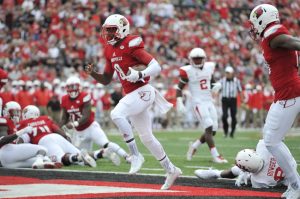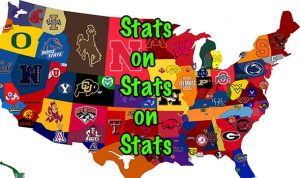College Football Handicapping – Powerful and Balanced Offenses
Isolating the Powerful, Balanced and Efficient Offenses in College Football
As we make the turn past the halfway point of the college football regular season, we can now utilize some stronger statistical numbers in evaluating teams and match-ups. All BCS conference teams have now played 2-4 conferences games to give us realistic projections on their performance vs. similar opponents. No more “false favorites” who padded their numbers vs. a soft non-conference schedule.

Louisville’s Offense has been most efficient, led by Heisman Trophy favorite QB Lamar Jackson
I annually research and document statistical profiles of teams, both offensively and defensively. One of the indicators I use for offensive strength is not just yards gained or yards per play, but how the teams accumulate those yards. Evaluating opponents and strength of schedule is another factor you must analyze once you review the numbers and statistical profiles.
Let’s take a look at the offensive side of the ball. One specific area of strength I pay attention to at this time of year are college football teams which have strong, balanced offenses. As a guideline, I look for teams who both run and pass the ball for over 200 yards-per-game on average. This is the college football ‘200 Club’, as offensive balance is a key component to offensive efficiency. As scoring and offensive production has increased in more recent seasons, we adjust are numbers and parameters. As of October 16, 2016 there are 27 teams that both run and pass for at least 200 yards per game.
However, offensive efficiency must also include scoring, as teams must be efficient in the red zone and also accumulate points. In addition, the strengthen the criteria, teams must also accumulate at least 450 yards per game, 6.0 yards per play and meet minimum efficiency yardage in yards per rush and yards per pass while scoring at least 30 points per game against FBS opponents.
So here are your ‘200 Club‘ most efficient offensive teams, and the 20 teams that meet the current criteria of powerful and balanced offenses. These stats are taken from FBS games and opponents only.
YPR = Yards Per Rush
YPP = Yards Per Pass
YPPL = Yards Per Play
PPG = Points Per Game
| Team | Rushing | YPR | Passing | YPP | Total Yds | YPPL | PPG |
| Louisville | 305 | 7.2 | 322 | 9.2 | 627 | 8.0 | 52 |
| Ohio State | 300 | 6.0 | 216 | 7.8 | 516 | 6.6 | 49 |
| Baylor | 284 | 5.5 | 275 | 8.1 | 559 | 6.5 | 41 |
| So. Florida | 278 | 6.3 | 239 | 7.9 | 517 | 6.9 | 42 |
| Texas A&M | 274 | 6.7 | 231 | 6.5 | 505 | 6.5 | 35 |
| Alabama | 265 | 6.2 | 239 | 8.1 | 504 | 6.8 | 45 |
| Auburn | 262 | 4.8 | 217 | 8.8 | 479 | 6.0 | 32 |
| Oregon | 259 | 6.0 | 230 | 7.8 | 489 | 6.5 | 33 |
| Michigan | 255 | 5.7 | 215 | 7.4 | 470 | 6.2 | 50 |
| W. Michigan | 250 | 5.2 | 224 | 8.8 | 474 | 6.4 | 40 |
| Texas | 239 | 4.8 | 261 | 7.8 | 500 | 5.9 | 38 |
| Washington | 232 | 5.9 | 264 | 10.0 | 496 | 7.3 | 51 |
| Toledo | 225 | 4.8 | 349 | 11.1 | 575 | 7.2 | 42 |
| Tulsa | 224 | 4.5 | 244 | 6.6 | 467 | 5.1 | 34 |
| Florida State | 220 | 4.9 | 272 | 8.3 | 492 | 6.1 | 32 |
| Nebraska | 220 | 4.7 | 233 | 8.7 | 454 | 6.1 | 35 |
| West Virginia | 211 | 5.2 | 300 | 8.1 | 511 | 6.5 | 32 |
| Colorado | 207 | 4.5 | 295 | 8.6 | 501 | 6.1 | 36 |
| Oklahoma | 203 | 5.0 | 323 | 10.0 | 525 | 7.0 | 40 |
The seven additional teams that run and pass for at least 200 yards per game but miss out in scoring or the other criteria mentioned include: Arizona, Ball State, BYU, Georgia, Hawaii, No. Illinois and Utah.
Note again this year we’re seeing overall stronger offensive yardage averages. Clearly there are some strong offensive teams that score plenty with pass heavy attacks like Texas Tech, Oklahoma State, La. Tech, Houston, Washington State and Ole Miss. But they don’t have the balanced attack in the running game. A team like Pittsburgh has a powerful running game and scores 40 points per game, but falls shore in the passing game at 180 per game. And the two leading rushing teams in the country are New Mexico and Army, who run the option, but are also the worst two teams in passing yardage. Air Force, a perennial power option rushing team is again top-15 at 250 YPG, and this year the fly boys are also passing with more success at 181 yards per game with a nation-best 11.3 yards per pass.
Currently there are 40 teams that rush for at least 200 yards per game (31% of the 128 FBS teams) and 45 teams that pass for at least 250 ypg, as teams that run for 200+ and pass for 250+ are your most powerful and balanced offensive teams – there are currently 9 such teams: Baylor, Colorado, Florida State, Louisville, Oklahoma, Texas, Toledo, Washington and West Virginia.
 The ability to run the football effectively also helps on the defensive side of the ball by keeping a defense fresh. When a defense is on the field for more plays per game and facing a hurry-up and spread passing attack, it can wear them out. But clearly if a team struggles at the point of attack and cannot stop or slow an opponent’s running game, it will effect more areas of the game including ball control and the clock. So that’s why having a balanced offensive attack is more potent and efficient and can be counted on when an opponent team does slow one facet of the offense.
The ability to run the football effectively also helps on the defensive side of the ball by keeping a defense fresh. When a defense is on the field for more plays per game and facing a hurry-up and spread passing attack, it can wear them out. But clearly if a team struggles at the point of attack and cannot stop or slow an opponent’s running game, it will effect more areas of the game including ball control and the clock. So that’s why having a balanced offensive attack is more potent and efficient and can be counted on when an opponent team does slow one facet of the offense.
Currently, there are 40 teams that average at least 440 total yards-per-game on offense; as total yards average is up again this season. Of course, you need to evaluate previous opponents and adjust accordingly based on opponent strength of schedule and the upcoming schedule and opponents defensive strengths to feel more confident in your team’s ability to sustain their offensive production and balance. The power teams can be attractive teams to bet on, especially as an underdog. If our power team has a strong defense to support this high-powered balanced offense then they often become an even stronger play in an underdog role; a situation I’ve used many times in recent seasons.
Good defensive coordinators can take an average defense and slow down another team’s offense if they lack balance. Thus, high-powered passing teams that lack a solid running game are susceptible to an inconsistent performance, especially if their own defense is not up to par to hold down an opponent.
Update your numbers weekly and pay attention to on-field performance, especially vs. quality opponents. Note turnovers, special team’s scores and turnover margin when evaluating box scores and not just the final score and result. You’ll be laying a pretty big price with some of these power teams in the weeks ahead, so continue to evaluate on-field performance and dig deep into the injury reports as well. Pay attention to key losses and how a team performs so you can project letdown situations and recognize when a team has a match-up edge. As you become more proficient in evaluating team’s strengths and weaknesses, you’ll find yourself with more tap-in birdies, and build your bankroll by getting the green.

 Twitter
Twitter Facebook
Facebook